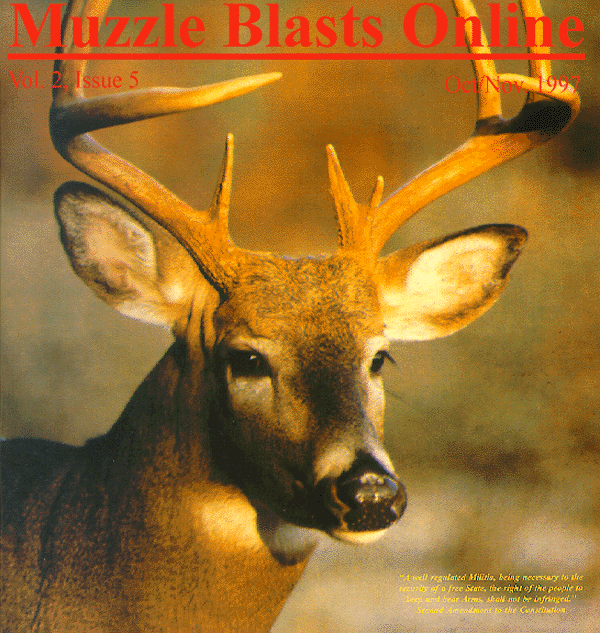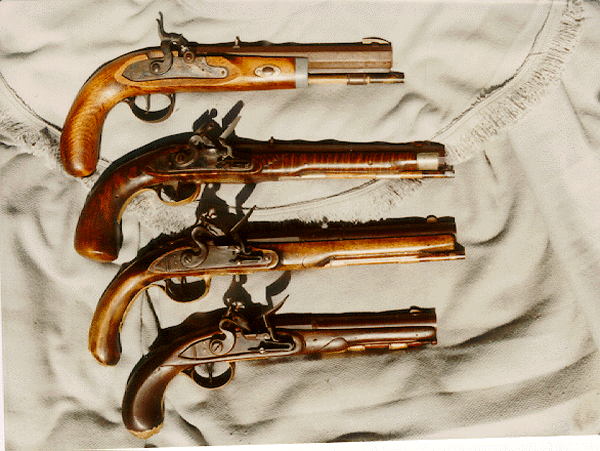|
Muzzle Blasts Online |
|
...for the muzzleloading enthusiast |
|
The muzzleblasts.com domain, subdomains, content, etc., are neither affiliated with the NMLRA nor its paper magazine Muzzle Blasts |
|
Muzzle Blasts Online |

|
|
|
|
|
|
Shooting Single Shot Pistols

|
There are probably more pistols in use today than in earlier centuries. A single-shot pistol in the early years of our country was likely to be a smoothbore and often carried no sights, or just a front sight. It was not intended for sport or target shooting, but rather for defense at close range. Despite the lack of sights, which most of us would find a serious shortcoming, pistols were fashioned in proportions which helped them point naturally and comfortably. Owners of single shot pistols were probably rather well-off by the standards of that time, since most people living closer to subsistence level who needed a firearm had to choose a single efficient piece for hunting and survival purposes, i.e., a long gun. Pistols were sometimes used in pairs by travelers who carried them in bucket holsters over their saddle. And we know that pistols had replaced swords and were used on the field of honor among not-so-gentle men who felt compelled to answer some offense.
Nowadays we are fortunate to turn these single shot pistols to enjoyable use in target shooting. Sometimes when I have not shot my rifle particularly well at a match, my pistol has saved the day and kept me from going home empty-handed. Pistol matches seem less crowded, so opportunities to place may be a little better than in hotly contested rifle matches.
Different pistols are suited to different matches and targets. I always prefer to sight in for a dead-on hold (rather than six-o'clock); that allows shooting on targets of various sizes and shapes and at different distances. If I change from 25 to 50 yards in bull's-eye matches, I increase powder charge and keep the same center-hold sight picture. A friend has a .36 flint pistol which he has owned and fired for a good 25 years. At short distances, his powder charge is 15 grains of FFFg; at 50 yards, the charge is increased to 25 grains. That small-caliber pistol is well suited to many types of paper targets (bull's-eye, animal, and 18th-century bottle, for example). But it's at a disadvantage on some primitive targets encountered on woods walks, such as gongs, ball-splits, breakables, and steel knock-downs. Those types of target clearly favor a larger caliber with more power to flatten a silhouette or ring a gong loudly enough for the scorer to hear. On a course that includes such targets, the same friend changes to his .54 flint pistol. In my own .50 flint pistol I use 30 grains of FFFg--half of my rifle charge-for most purposes.
Bull's-eye paper targets usually are shot one-handed, but some primitive matches allow a two-handed hold. Fundamentals of stance and hold are always important, but since single-shot pistols come in so many shapes and sizes, it's a little hard to generalize. For a one-hand hold, I face nearly ninety degrees away from the target; with two hands, I use what's referred to as the Weaver stance: facing the target directly, with elbows locked, and supporting hand under and slightly overlapping the shooting hand. With my flint pistol, my trigger finger contacts the underside of the lock panel and actually provides a little support to keep the muzzle from sagging. I gradually draw the trigger straight back without changing sight alignment. I believe that the grip of the shooting hand will vary among individuals and pistols; the most important thing is to keep the grip consistent from shot to shot. Generally speaking, the hand should be fairly relaxed, with even pressure from all fingers. My thumb curls over the top of the pistol grip to touch the same spot on the finial of the panel opposite the lock. That's a reference point that works for me based on the geometry of my hand and pistol; you may find a similar arrangement with your equipment.
In aiming, you'll find it important to focus primarily on sight alignment. Your eye won't keep three reference points--rear sight, front sight, and target--in perfect focus. Sight picture clarity will help your shot more than a little target fuzziness will hurt it.
I believe that one of the most crucial elements in good shot delivery is follow-through: keep looking through your sights at the target until your ball has passed through the paper or hit the gong. That way, you'll be concentrating intently on sight picture and will not be disturbed by report and recoil. If you're too acutely aware of these, you may flinch, and pistols are quite unforgiving. [Editor's note: How well I remember the first match in which I fired my flintlock pistol! I'm sure I fired twenty-five shots to hit the paper ten times. I suspect I committed every error known to pistol shooters, but lack of follow-through was probably the most damaging one.]
Dependable equipment is essential to good pistol shooting. At the very least, your lock should be quick and strong, and a good sparker in the flintlock variety. Flintlocks will benefit from a good flash-hole liner. I like stainless or Ampco liners flush on the outside and coned inside. Flash holes are usually in the 1/16" to 3/32" range; mine is 5/64". A flash hole that's too small can be carefully opened up with the next-larger drill. And while a flash hole that sits too low can't be raised, the same effect can be achieved by grinding away a little bit from the bottom of the pan. A crisp, fairly light trigger with no drag will be a help (and a single set trigger will be even better for serious target work). If you make your pistol from scratch or a kit, you might place your rear sight as far back as the breech plug tang to increase your sight radius.
If you shoot a smoothbore pistol with only a front sight, you will probably have to experiment with sight pictures and memorize what works. The absence of a rear sight doesn't mean you're totally without reference points: the center of your breech plug tang, the tang bolt, or even some detail of relief carving or a step in an octagon-to-round barrel can act as references as you look down the barrel.
With all pistols, it's wise to use a rest when sighting in and finish the job offhand. I believe in using just enough powder to do the job well. Sight corrections are made by filing to correct height and driving left or right in dovetails. When I was developing a load for my pistol, I settled on one thickness of patch material which allows easy loading and stays together well in shooting. Fired patches recovered from the ground are dirty but intact, with no holes blown or cut in them by loading or shooting.
Various states may allow hunting with muzzleloading pistols, but you should check game laws carefully. Some specify minimum caliber, charge, and barrel length, and many pistols may not qualify. Small game hunting may hold great possibilities, particularly with a smoothbore loaded with shot.
There are many sources of single-shot pistols, and some are bargains. Even mail-order catalogs offer them. Some good ones are no longer manufactured, but still turn up used. Custom and semi-custom makers offer the best pistols; many are advertised in Muzzle Blasts. I have seen products by the following makers and know that they are reliable and capable of shooting far better than most of us can hold: Lyman, Thompson/Center, Kennedy Firearms, CVA, JP Gunstocks, Navy Arms, The Gun Works, and North Star West, to name some of the most prominent ones. You might consider making your own pistol; while the project shouldn't be underestimated, it's a little less formidable than making a long gun and it's a good entry into gun building. If you start from scratch, you will want to select a barrel made expressly for pistols--with a fast twist--rather than a cut-off piece of rifle barrel. In choosing a pistol, you will want to choose a caliber based on its intended uses. The deciding factor may be the caliber of your long gun if the pistol is intended as a companion piece.
Single-shot pistols are capable of good accuracy and lend another dimension to such events as woods walks. If you become a good pistol shot, you may find your rifle shooting improves too. Most of all, I recommend single shot pistols because they are challenging, satisfying, and fun to shoot.